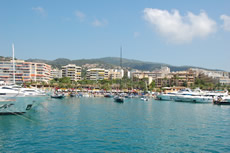- TEL +34 606 859 560

International Certificate of Competence (ICC)
Duration: 2 days
Student Ratio: Maximum 3:1
Previous experience required: None
A practical course covering the basics of seamanship, safety, manoeuvering, Rules of the Road and navigation, includingplotting a course. This course is only available to UK residents.
The ICC is required by most European countries for certain categories of pleasure boat. It is also useful in countries where compulsory certificates are required of nationals simply because officials expect to see such a certificate. RYA publications C1 and C2 Planning a Foreign Cruise give the details of the certification required for all European countries.
ALL CANDIDATES -
REGULATIONS
- Knows responsibility for keeping a proper lookout
- Can determine a "safe speed"
- Can recognise a potential collision situation
- Can identify 'give way' vessel in a collision situation
- Knows what action to take as 'give way' and 'stand on' vessel
- Knows responsibilities of a small vessel in a narrow channel
- Can recognise manoeuvring signals (1,2,3 & 5 short blasts)
- Can make and recognise visual distress signals
SAFETY
- Is able to use and instruct crew on the use of:
Lifejackets
Distress flares
Fire extinguishers
'Kill cord' (if fitted) - Can prepare a boat for use and take sensible precautions before setting out, including:
Engine checks
Check fuel for range/duration of trip
Obtain weather forecast
Avoid overloading boat
ADDITIONALLY, FOR CANDIDATES FOR COASTAL WATERS -
REGULATIONS
- Knows rules relating to Traffic Separation Schemes
- Knows requirements for navigation lights and shapes to be displayed by own vessel
- Can recognise the following from the lights:
Power driven, sailing vessel, vessel at anchor, tug and tow, fishing vessel, dredger - Knows sound signal to be made by vessels as in Q3
PILOTAGE
- Can recognise, by day and night, and understand significance of buoys of the IALA system
- Knows sources of information on: local regulations, port entry and departure signals, VTS and Port Operations Radio
- Can plan a harbour entry/departure, taking account of possible presence of large vessels and avoiding navigational hazards
NAVIGATION (Chart & Plotting Instruments required)
- Can interpret a navigational chart, understand significance of charted depths and drying heights and can identify charted hazards
- Can plot position by cross bearings and by Lat/Long
- Can determine magnetic course to steer, making allowances for leeway and tidal stream
- Can use a tide table to find times and heights of high and low water at a standard port
- Can determine direction and rate of tidal stream from a tidal stream atlas or tidal diamonds on a chart

Steve Wickenden,
Director of Balearic Sea School

Puerto Portals Mallorca

